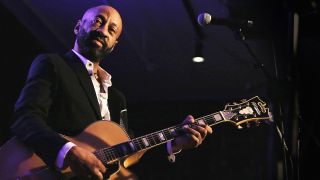Features

(Image credit: Getty Images)
Most know Frank Stribling, aka Binky Griptite, for his chunky yet funky rhythm guitar with Brooklyn’s Dap-Kings, who have long backed up Sharon Jones as part of a resurgence of ‘60s funk and soul.
He started out on bass after he became enthralled by Parliament Funkadelic’s Bootsy Collins. The six-string didn’t come until later – and didn’t click until Griptite heard Ted Nugent’s Cat Scratch Fever, sending him on a journey from his hometown in Milwaukee to Minneapolis in the late ‘80s to New York City in the ‘90s, where he reinvented himself as a hollowbody-wielding rhythm player.
Even before he could poperly play, Griptite’s days were spent ogling his Korean knockoff Ibanez Iceman and poring over guitar mags at his local pharmacy. “My first real guitar story is when I got in trouble with the law for shoplifting,” he says. “I stole a copy of Guitar World from the newsstand with Andy Summers on the cover.
“I’ll never forget it – he was holding a Shoreline Gold Fender Strat, and there was a big picture of him in the centerfold. I was pacing around Walgreens for about an hour, trying not to be noticed, and that obviously gets you noticed more. And when I finally decided to walk out, security was right behind me.”
Thankfully, his brief flirtation with a life of crime didn’t impact his future career. In his 20s, Griptite featured on Janet Jackson’s Janet (1993), making a name for himself as a session ace who could shred. But there followed an identity crisis; he put his guitar down and moved to New York City, becoming a different person and a better player by his estimation.
With the Dap-Kings, he became a premier funk player, and soon caught the ear of Mark Ronson, who, in 2006, was working on what would become Amy Winehouse’s Back to Black. Griptite would feature on six tracks and tour the world with Winehouse before settling back into the Dap-Kings.
He quit the band in 2018, but still looks back with fondness. “We were great, man,” he says. “People loved the band, but the thing is that everyone thinks of the Dap-Kings as a horn band.
“The truth is that the band wouldn’t have worked without guitars. If the guitar players miss the plane and aren’t at the show… the horn players won’t be able to do it all night. So, I’m proud of what we did.”
What inspired you to play guitar?
“I always loved music. Bootsy Collins was my first hero – my brother used to take me to Parliament Funkadelic shows in the ‘70s. I was into guitar; but in funk music, the bass can be a lead instrument, and I was into that. So it took some time for me to get into guitar, which came through a classical guitar that was too big for me to play! So I got a bass when I was 12.”
Did you take lessons?
“I didn’t – I bounced between bass and guitar until around 1981, when I saw Devo on a TV show called Fridays, and that did it for me.
“I saw Bob Mothersbaugh playing this blue Ibanez Iceman, and I went out to a local guitar shop and found a Korean copy that, eventually, someone in my family got for me. I had to have it. But even then, I treated it like a toy; it wasn’t until I started messing around that I started figuring things out.”
You eventually made your way from Milwaukee to Minneapolis. What brought that on?
“I went there in my early 20s because the Milwaukee scene was brutal. I’d been playing in basement funk bands since I was 16, but the guys were all older than me. I became an excellent soloist, but had no feel for rhythm and I wanted to evolve.
“So I decided to move to Minneapolis post Prince’s Purple Rain because it was a vibrant scene. But even then, I was more of a blues rock player.”
You ended up featuring on Janet Jackson’s record, Janet, while you were there.
“Yeah, that was another reason I went out there – I knew Janet Jackson did records there. But I wasn’t really in the right frame of mind to work on the record properly, because of where I was at in life. She was coming off some big records and wanted to have hard rock guitars.
“Or I assumed that’s what she wanted. She came in with a song called What’ll I Do and wanted something different. I showed up with the wrong gear and not in the right frame of mind. But she was great; I was nervous around her because I’d had a crush on her since I was nine!”
You mentioned not being in a great headspace; what prompted you to move to New York?
“It’s a long story, but I got to a point where all there was left for me to do in Minneapolis was work for Prince – and I had no desire to work for him because I’d heard too many stories.
“I got bored with myself, bored with how I was playing, and felt inadequate as a rhythm player. I quit playing guitar for two years, moved to New York, and just became a New Yorker.
I’d gone the way of rock radio but I wanted to be a rhythm player, so I studied jazz chords and learned how to better connect them to play old James Brown songs
“I needed to give myself time to lose some chops, and then I could revisit music from my childhood, like all the funk stuff. I’d always been into Eddie Van Halen, Stevie Ray Vaughan and Jimmy Page, and with guitar, I’d gone the way of rock radio.
“But I wanted to be a rhythm player, so I studied jazz chords and learned how to better connect them to play old James Brown songs and things like that.”
Is that what led to The Dap-Kings?
“Yeah – we were called the Soul Providers back then. I was working as a bartender and just getting back into music, and I went to a DJ night where they were playing soul and funk.
“I ran into an old friend who said, ‘Hey, you’re a guitar player, right?’ I said, ‘Yeah,’ and she said, ‘You should meet my boyfriend; he’s a bassist,’ and that turned out to be Gabriel Roth. He let me know they were looking for a guitarist, and things went from there.”
What gear were you using when you joined?
“I was mostly playing Strats. I had a Strat and a Les Paul, but I had always wanted a hollow-body, and that’s when I went and found a cheap Carlo Robelli. After that, hollow-body guitars were mainly what I played.”
How did you end up playing on Amy Winehouse’s Back to Black?
“Mark Ronson was producing that record. He was aware of the Dap-Kings and he was a fan – as were a lot of people in the DJ community. Someone sampled our songs for a mixtape, and Ronson heard it when the legals for the song were happening.
“He started hiring horn players for the record, and eventually he needed a guitarist from that same Brooklyn scene, and my name came up.”
You couldn’t have known Back to Black would be so big, but was there an approach you took that lent itself to its eventual success?
“Oh, I had no idea it would be big when we were doing it. And Amy wasn’t there, so Mark came in with demos she’d done at home, and we started tracking. We learned the songs from the demos, and then he brought in a CD that had scratch vocals from her.
“That gave me a better feel, but it was hard at first and a bit of a learning curve. Once we got going and I caught the vibe, I realized the approach needed to come from the perspective that we were mimicking the sound of old-school records, but for a new era.”
What did your studio rig look like?
“I had a Strat and a Tele, which were both copies. I’ve always been into ‘80s Japanese Fender copies, and I believe I had a Tele from ’82 with a Seymour Duncan Alnico 2 pickup in it. You always need a Tele on hand, and from the second that one fell into my hands, I loved it. Aside from that, I think I had my Japanese Navigator Les Paul from the early ‘90s.
What was it like touring with Amy after Back to Black began to hit?
“She was cool. We had to rent amps, mostly Fender Deluxe Reverbs, because we were flying all over to do big gigs. I got linked up with Gibson, who graciously gave me a hollowbody that I modded out with new pickups.
“But really, it was just plugging into an amp and keeping it super-simple. I was the musical director for that tour, which was life-changing for me as a guitarist.
The power coming out of this tiny person – Amy Winehouse didn’t need anything to be huge. It changed my perception of acoustic guitars forever
“Amy would do these small promotional spots where it was just her and a guitar; it ended up being just her and me. I’d be standing beside her with a guitar and no-one else, and that’s when I got to see how cool she was, and the power coming out of this tiny person. She didn’t need anything to be huge, and the experience changed my perception of acoustic guitars forever.”
You’ve always got a lot going on between your Orchestra, DJing, and more. What’s next?
“I left Dap-Kings in 2018 because I had my fill of funk; I wanted to get back into blues because I was a blues player, and I still enjoy that. I’m getting more into danceable blues, which may be overly guitar-filled but still has cool sounds, just not with the guitar as the centerpiece.
“So I want to keep focusing on rhythm, like Howlin’ Wolf, Muddy Waters and stuff like that. I’m slowly working on a record at Electric Lady Studios with my Binky Griptite Orchestra, so we’ll see where the year takes me.”
Follow Griptite’s developments via his website.
Thank you for reading 5 articles this month**
Join now for unlimited access
US pricing $3.99 per month or $39.00 per year
UK pricing £2.99 per month or £29.00 per year
Europe pricing €3.49 per month or €34.00 per year
*Read 5 free articles per month without a subscription

Join now for unlimited access
Prices from £2.99/$3.99/€3.49
All the latest guitar news, interviews, lessons, reviews, deals and more, direct to your inbox!
Andrew Daly is an iced-coffee-addicted, oddball Telecaster-playing, alfredo pasta-loving journalist from Long Island, NY, who, in addition to being a contributing writer for Guitar World, scribes for Rock Candy, Bass Player, Total Guitar, and Classic Rock History. Andrew has interviewed favorites like Ace Frehley, Johnny Marr, Vito Bratta, Bruce Kulick, Joe Perry, Brad Whitford, Rich Robinson, and Paul Stanley, while his all-time favorite (rhythm player), Keith Richards, continues to elude him.
>>> Read full article>>>
Copyright for syndicated content belongs to the linked Source : GuitarWorld – https://www.guitarworld.com/features/binky-griptite-dap-kings































